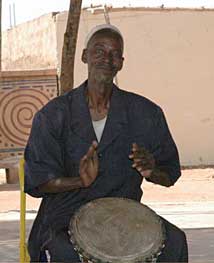When we concentrate only on soloing on the jenbe, and not learning or playing the dunun we are only experiencing the rhythm arrangement or composition from one small perspective.
You are relating to it from a small and stuck position. Its like driving down the highway and only seeing the back of the car in front of you. You can’t see the sides of the car, the front of the car or the top of the car if you only look at it from one position. How can you know what is in front of you if you can only see its backside?
By playing the kinkini, you can hear and learn to hear the jenbe from an entirely different perspective. Try this please. Play a jenbe part and then switch from playing that part and play the kinini while someone else plays the same jemnbe part you just played. If you pay attention, it will sound and feel completely different then you experience playing the same jenbe part. I guarantee it. If you move to the sangban it will sound different again as will the dununba part. Then you can see,hear and experience the composition from many different sides.
This is what you want. You want it (the jenbe part or solo parts) to sound different. By listening to all the different relationships, you learn how to hear the jenbe parts as a whole, it becomes multi dimensional instead of linear. Now the rhythm is living and breathing and you are freed up instead of stuck hearing it only one way.
if you want to play West African jenbe, you need to learn the basic jenbe accompany parts. Too many casual observers they seem simple and repetitive. But don’t be fooled. Each basic accompaniment part is a gift to you from the rhythm gods. Each part contains a world of information. A specific groove that takes a lifetime of study to really perfect. People think jenbe playing is about soloing. But it’s not. It’s about dunun, jenbe accompaniment and technique. It’s about intention and spirit, which happens when all the key ingredients are in place.
Learning to play the basic accompaniment parts will give you the feel and spirit of the jenbe. Through repetition and surrender (letting go of ego expression, “having to be the man”) we can receive the gift of the groove. The feel and the spirit. You won’t get it by only soloing and skipping learning to play the dunun and accompaniment parts.
The best jenbe soloists are solid dunun players and solid accompaniment players as well. So many of us want to rush ahead and be soloists, to express ourselves. But some can not play the basic accompaniment parts correctly. And their solos are ungrounded. The solo is the icing on the cake and not the cake itself. The rhythm composition, the dunun and the accompaniment parts are the cake.
If you were to build a house, you would not build the roof first. You would lay the foundation. then you build on top of the foundation. The dunun and accompaniment parts are the foundation you build on. Take the correct steps and build your jenbe house correctly. Crawl before you walk. Its never too late to go back and learn to play correctly either.
Often people play solos clearly, but not their accompaniment. They save or put all their energy into the solo. However, if they were to put that same creative juice into their accompaniment parts, if they took more of an interest in their accompaniment then their solos would in turn become stronger and have deeper groove as an end result. The accompaniment parts will teach you grooves. To groove. To develop pocket. Without grooves there is no pocket. With out pocket you are just fiddling around.
If we were not born into this tradition or grow up with it, then it is very helpful to come to this music humbly. We need to realize that we are all students of this great art form and it is a life time of study. Keep open minded, positive and leave your ego at the door.

